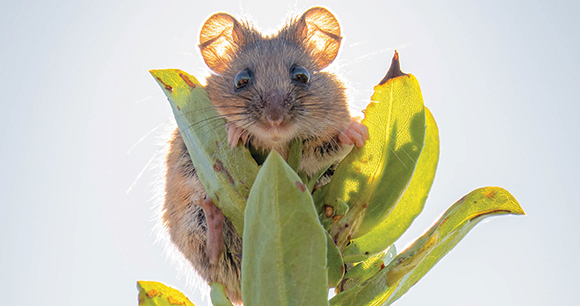by Dr. Cody Aylward and Dr. Mark Statham, Mammalian Ecology and Conservation Unit, UC Davis
The salt marsh harvest mouse is an endangered species restricted to the coastal wetlands of the San Francisco Estuary (SFE). Since the beginning of the industrial revolution, approximately 90 percent of the historical tidal marsh habitat in the estuary has been converted to urban development, salt ponds, or other land uses. Only 48 square miles of salt marsh habitat remains in the SFE, and not all of it is occupied by salt marsh harvest mice.

Understanding the extent of a species’ range is one of the most basic elements of its conservation. However, acquiring this basic information is not always easy. For salt marsh harvest mice, their range is typically assessed using live-trapping data, which can be problematic, as few individuals are permitted to trap this endangered species, and live-trapping is an exhausting effort with an inherent risk of mortality. To address these difficulties, scientists have elected to monitor a small number of sites to assess population trends over time, rather than assessing the entire species range, meaning that a significant proportion of the range has not been surveyed in decades, or ever.
Using funds from a Christine Stevens Wildlife Award, we developed a novel, noninvasive genetic approach to survey the salt marsh harvest mouse across its range, a technique that is less expensive and labor intensive, and has lower mortality risk than live-trapping. The approach used bait stations, which allowed mice to enter, eat some seeds, enjoy the cotton bedding inside, and deposit feces. We then collected the fecal pellets and subjected them to a novel polymerase chain reaction (PCR)–based genetic test (dubbed “whopoo”) that we developed in the Mammalian Ecology and Conservation Unit at the University of California, Davis, to determine which of five rodent species that occupy the SFE visited the stations.
Of the 47 marshes surveyed during the winters of 2020–21 and 2021–22, we detected salt marsh harvest mice in 24 of them. This new genetic tool was extremely effective, resulting in a 99 percent chance of detecting salt marsh harvest mice if they were present. We found that the size of surveyed marshes and their connectivity to nearby marsh habitat were important predictors of whether salt marsh harvest mice occupied the site. We also found that several areas that were considered part of the species’ range are no longer occupied. Our results have important implications for updating the species range and guiding future conservation efforts.
Our research demonstrates the effectiveness of noninvasive approaches to understand the distribution of this endangered species. This study has already had a positive impact on future monitoring of salt marsh harvest mice. During the summer of 2022, a multiagency range-wide survey effort used this noninvasive methodology to increase the number of sites that could be feasibly surveyed. Very few noninvasive genetic surveys for small mammals have been developed to date, and we hope that other scientists will consider similar approaches to improve the noninvasive monitoring landscape for small mammals globally.